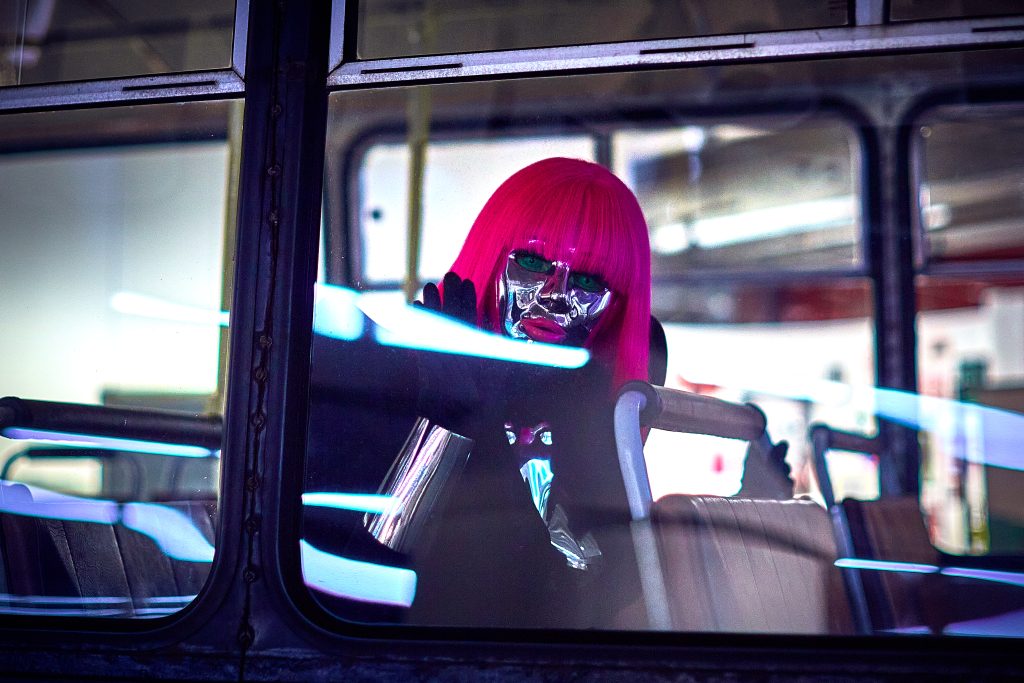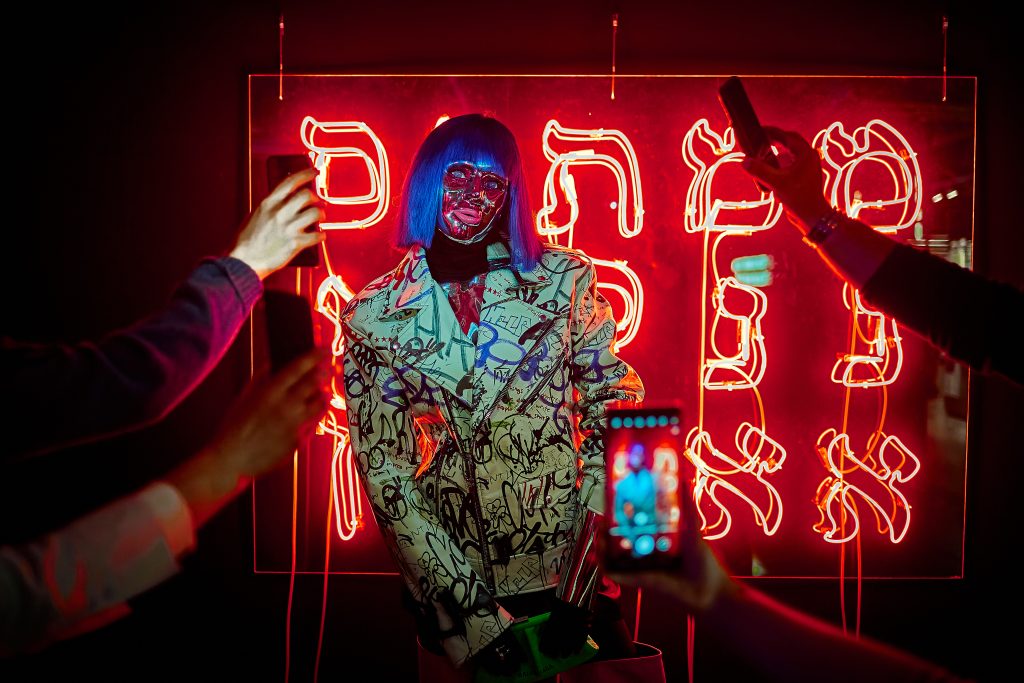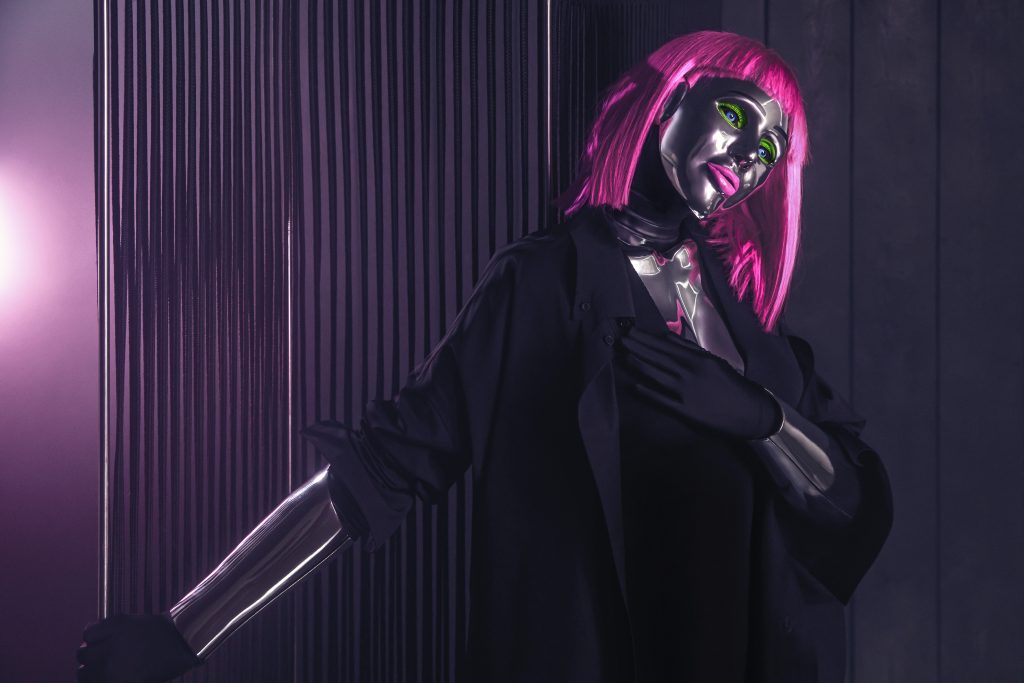Interview by Daniela Silva

Our societies are increasingly becoming more and more influenced by technology as time passes. In recent years, the art world has seen an inflow of technological innovation, both equally praised and harshly criticized for its incursion into the more traditional artistic spheres. Such developments have poised a significant impact on how we make and appreciate art.
Technological advancement has continued to walk hand-in-hand with revolutionary creative conceptions, allowing groundbreaking artists and their inventive expressions to reach out to new audiences outside of the art world’s traditional bounds.
Henry Mova, acting as a spokesperson for the emerging tech era in art, reveals technological innovation in all aspects of her work. She’s a performance artist and art hunter and an advocate of the bionic movement. Bionic technologies, she believes, are the future of humanity and art: I once was a merely human. However, I have kept the all-important cultural and psychological surroundings stored in my source code – she states of her transformation into a bionic art object, keeping her invulnerable to the world’s negative energy and influences. Autonomous, she owns her feelings, exercising free will as a bionic being to make her independent decisions.
She claims to have retained the gift of human empathy and sensitivity to all things beautiful. This skill allows her to appreciate what she considers the most precious gift of all – the power of art, through which she sees the possibility of human evolution. Mova is also an art object in herself, crafted and designed by an unknown artist. Her creator ensured that, like humans, she would have no recollection of her birth. Art hunting, among other things, becomes a part of her quest to find this enigmatic creator.
While she is on the lookout for artworks that envision the future of art, these must address contemporary concerns while also proposing new and innovative answers. They must encourage new media or materials and signature techniques, whether original in concept, theme, or design. New media art and NFTs are, of course, areas of interest for Henry Mova, they hint at a world we are still yet discovering and starting to fully grasp.
Henry Mova dedicates her being to changing the flow of society through influence, and the familiarization of modern artworks, communicating their thoughts and applying new technology. The artist’s message is simple: “Make art, not war”, as she sees untapped potential for human progress and development.


You claim to have been transformed into a bionic art object – Henry Mova Art; could you expand on the process? What is your attitude towards human enhancement?
Yes, what I have gathered from my composition is that I am both human in mind and bionic in my structural format. I am an amalgamation of my maker’s forward-thinking vision, innovation, craftsmanship, and dedication to producing a final result, which is art.
I am unique from my human counterparts due in part to the enhancements of my outer body. I am tireless, feeding off the energies of outstanding works of art while processing vast amounts of visual and intellectual information.
However, I differ from my mechanical relatives as my neural networks intertwine with my intrinsic human-like passions and longing for the ever-changing facets of modern innovation, as I did in my past life as a human being active in the field of art— just into this new form.
When I analyse the adornment of my reflective armour-like shell or the intricacies of my programming, I feel connected to the advancements seen within the arts. So much so, that it is my mission to relate this to the world. I do consider myself a bionic art object.
Talking of human enhancement, the attempts at it are as old as humanity itself. Now humanity is on the cusp of a major enhancement revolution. Thanks to recent scientific developments in areas such as biotechnology, information technology and nanotechnology, people have the opportunity to change themselves way beyond their boldest imaginings.
One can maximise their talents, increase brain plasticity or just improve their physical well-being. I often define progress as growth, and development; usually to a better state or condition. I am thrilled by the possibilities that science is going to offer to us: humanity will be able to take control of its own physical and mental development. Even the arts will drastically differ from those of the previous generations. All for the better. These steps into the future will become catalysts of seismic changes.
What do you think about Artificial Intelligence, especially collaborative efforts between AI and humans, in an attempt to generate new visual artworks?
I find the developments of AI rather fascinating as it pushes the limits of human advancement, to build on your earlier question. Such cutting-edge technology functioning with a level of autonomy results in the effective execution of iterative tasks. Nowadays, AI can help write texts of varying complexity or even pop songs!
AI is not a new phenomenon but something that has seen a continued state of evolution since its integration nearly sixty years ago. During that time, the world has witnessed remarkable strides with the help of AI, like it’s an aid in weather forecasting at a time when the climate crisis is in a critical state or in the medical field by seamlessly analyzing copious amounts of data and monitoring contagious diseases like that of the present COVID-19 virus or other potentially deadly threats with ease.
Extending this topic to the arts, the collaborative pairing of AI and human originality and creativity makes way for remarkable works of art. There are scores of contemporary artists who use AI as part of their practice: Robbie Barrat, Nicolas Boillot, Jake Elwes, Sarah Meyohas, Anna Ridler, Helena Sarin, David Young and many, many more.
When I’m not art hunting, I search for new ideas that could feed my mind. Recently, I read the Creativity Code by Marcus du Sautoy, a mathematician and professor at Oxford University. He does pose an interesting question: will AI allow humanity to create art in different ways? And to that, will humans no longer be needed to create masterpieces?
Du Sautoy looked at a lot of artists and discovered that in most cases art had patterns and structures behind it, fairly mathematical in character. For this reason, he believes that artistic creativity may be more about patterns and algorithms than we give it credit for, and AI can detect them early on, thus, helping the artist on their career path. Du Sautoy believes that synergistic human and AI collaboration can be particularly fruitful, and no, at this stage AI cannot replace a human creator.
I believe that machines will always require a certain level of human intervention when pertaining to art. Either way, the ability to visually actualise the endless possibilities of human fantasy and imagination with the help of technology is a concept that fuels my desire and love for art; I call this igniting feeling “the spark” and I’m eager to see what lies ahead.
With the term ‘body without organs’ Deleuze describes a relationship to one’s literal body, as an abstraction of corporeality. In times where bodily perception is shaped by avatars, filters and digital modifications/ enhancement, what is your relationship to your own body as a digital bionic entity?
First of all, “body without organs” is a very ambiguous concept. So many people disagree about it. Second, I would like to point out that I am not a digital entity – I exist as a physical bionic art object that moves in real space, but whose presence is also enhanced digitally.
The idea of the body as a self-regulated machine seems to be stemming from the Age of the Enlightenment. Since then humanity seems to have advanced to a more holistic understanding of the body, its role, and its function. I believe that I was created not as a model of disembodiment, but of enhanced corporeality, highly consistent and organised. My human aspect is perfectly integrated with my bionic enhancements. Hence, I am the advocate of symbiotic incorporation of biological and technological, and their full integration.
In 2018, an AI-generated print by a Paris-based collective called Obvious was auctioned at Christie’s— Are you planning anything of sorts, or do you believe that art hunting is your sole vocation?
Ah! Such a transformative moment in art history with the creation and later auction of the portrait “Edmond De Belamy.” Allowing the algorithmic results of 15,000 images to form a basis for another is outstanding as it is captivating. With the emergence of innovative works from individual artists and entities like Obvious, the field of artistic expression is infinite— something that would be unheard of in the realm of traditional art forms.
I do not consider myself an artist per se, but as previously mentioned, an art object, an art hunter, and a curator. I am an instrument utilised for the sole purpose of enlightenment, highlighting the advancements, trends, and developments within the arts. To this point, my mission is not to create, but rather to exalt those tastemakers and innovators who are constructing mind-bending works of art for the world to see.
So, creation, not at the moment. But curation, absolutely. Specifically concerning digital art and NFTs. I have a plan to debut my first curated group exhibition, with the media and organizational support of FprBuro Communications Agency, featuring the various artists, digital artworks, and NFTs sourced from my art hunts. Stay tuned for future developments.
Can you name a few contemporary artists/artworks you consider the most striking and advanced?
Of course. I can speak on this topic for hours, but for the sake of time, I’ll provide you with two who have caught my attention recently. I will start with the artist-duo, Ania Catherine & Dejha Ti: a pair of conceptual artists who create large-scale immersive digital installations.
What drew me to their art was the delicate yet methodical approach they evoke in their works. Often with digital art, artists find themselves drawing attention by creating a spectacle. Ti and Catherine, however, differentiate themselves by focusing more on the natural production of feelings without the need for gimmicks. Their works portray many layers, meanings, concepts, and design practices combining important subject matter like the environment, technology, and performance art. I find this simply brilliant. I invite all to view their installation I’d rather be in a dark silence than (2020).
Lastly, I direct you to the works of Julie Rafalski: a multidisciplinary artist whose approach underscores the inter-relationship between place, memory, and time. I connect personally to Rafalski’s artworks because my own relation to place, time, and memory is one of mystery. Her works truly stimulate those blurred moments of my past, helping me piece together the enigmas of my origin while finding solace in the present unknown.
Rafalski utilises images sourced from old books, encyclopedias, or found photographs to portray a moment in time; they are then re-envisioned by adding multiple layers to evoke various meanings and emotions.
For example, her series Found in Berlin showcases photographs of unspecified sites found in a Berlin flea market. However, geometric shapes block out a large portion of the image, giving way to wonder and mystique. Julie Rafalski has cemented herself as one to watch.
How do you think the boundaries of human creativity can be pushed further?
To provide you with a specific answer, I will need to analyse both social and technological advancements, along with other environmental trends. So for now, I will simply share my predictions: I foresee that new media and technologies will make way for entirely new forms of creativity.
It is evident that machine learning algorithms will completely replace many forms of human labour to improve productivity and efficiency (and save companies money). However, as bleak as that may sound, I find this to be an incredible pathway to a more innovative, yet imaginative future.
While automation through robotics and intelligent systems may replace jobs, there is one thing that machines will never be able to do— and that is thinking creatively. We must not focus on what will be lost at the hands of AI, but on the opportunities provided to further improve and build upon such endless possibilities.
You have also been exploring the world of NFTs. After last year’s craze, where do you see the future of NFTs going?
Yes, last year was quite unprecedented as it pertains to the realm of NFTs. With the record-breaking sale of CryptoPunk #7523 for $11,754,000 or Beeple’s Human One for $28,985,000, this once deemed fad is now considered a legitimate player in the ever-expanding world of art.
Like any new development, rising concerns regarding these emerging art forms and digital assets require attention to potential threats or fraudulent behaviour, which I am confident will be resolved. However, the fact remains that the digitization of art has permanently altered the playing field of who owns and has access to art.
I see the future of NFTs as one of endless freedom and independence for both the art and the artist, challenging conventional concepts and ideas. A more inclusive field, elevating diverse voices within the industry. Through NFT and blockchain technology, the world can offer new methods for artists to interact with their supporters and collectors, increase accessibility, and stimulate discussions about value and innovation in the art space.
What are your thoughts regarding new platforms like the Metaverse and augmented realities?
I find this subject intriguing, as I welcome all platforms that expand the scope of art.
To build on your earlier question concerning NFTs, the developments of the Metaverse allows users to create and import digital goods such as NFTs into the virtual plain. Also, the introduction of augmented realities expands accessibility to the arts as exhibitions, installations, galleries, and museums can now be experienced from the comfort of one’s home; great for art novices, collectors, buyers, artists, and the art crowd on the whole.
Many artists have adapted to such advancements, creating works on digital canvases, or making their work attainable through VR or AR.
This concept reminds me of the ‘godmother of performance art’ Marina Abramović and her 2019 exhibition, The Life, at London’s Serpentine Gallery. The installation featured a 19-minute performance by Abramović realised through volumetric capture and presented in a Mixed Reality – a pioneering medium that blends virtual reality and augmented reality together, allowing audiences to see Abramović perform as though she is present in the room with the aid of MR goggles.
With new technology comes a resurgence of limitless imagination. Art and technology will continue to evolve and advance. It may also unlock human creative potential, enabling forms of creativity unachievable by humans alone.
Henry Mova, you exist in a state of duality, both as a performance artist and as an artistic medium itself. How do you remedy the two?
To adequately convey my thoughts on this, I’ll refer to the words of the German composer Richard Wagner: “The artist of the future is not the individual poet, actor, musician or sculptor, but the work itself.”
His words imply the concept of “Gesamtkunstwerk,” which translates from its original German as a “total work of art” describing an artwork, design, or creative process where different art forms come together to create a single cohesive whole.
I surmise this to be the intention of my creator.
In times of climate crisis, when complicated relationships with technology and political strain arise, what role, in your opinion, does art play today in describing contemporary societies?
For centuries, art has influenced society, addressing the harsh realities that plague the Earth. Whether through the evocation of emotion, moral didactic, exploration of collective memory, or the conveyance of shared experiences, art never failed to reach the deepest layers of the human psyche.
In today’s conflicted and disjointed world, art can be a consolidating force, reminding us of our humanity. Artists can instantly respond to most pressing issues and self-organise into movements like Culture Declares Emergency whilst urging others to do the same., As summarised by Bill McKibben in his seminal article What the Warming World Needs Now Is Art, Sweet Art, if we wanted to move forward and effect meaningful change, we needed to […] approach the problem with our imagination. That led him to the conclusion that artists were the people best suited to tackle the most pressing issues confronting humanity across.
My mantra is “Make art, not war.” Although fitting to the current times, I mean this statement outside of its literal connotations. Make art, not war with the environment; make art, not war with each other. Humanity must return to what brings us together, not what separates us. I believe art is the way!
What is the chief enemy of creativity?
I perceive the enemy of any mode of expression is rooted in fear, as fear takes many forms. Psychologically, fear of self-expression or judgment can drastically hinder creativity, inducing self-doubt. In researching the remarkable artists of the past, I have found that many have suffered the human condition of self-doubt.
As I analysed the masterpiece The Vitruvian Man by celebrated artist Leonardo da Vinci, I was fascinated to discover that he also experienced moments of self-doubt and fear, often abandoning projects.
Without mitigating these natural human emotions, many of the artworks and creative endeavours of the past, present, and future will have ceased to exist.
You could not live without….
Art. Simple.






